Serviços Personalizados
Journal
Artigo
Indicadores
-
 Citado por SciELO
Citado por SciELO -
 Acessos
Acessos
Links relacionados
-
 Citado por Google
Citado por Google -
 Similares em
SciELO
Similares em
SciELO -
 Similares em Google
Similares em Google
Compartilhar
Revista de Ingeniería
versão impressa ISSN 0121-4993
rev.ing. no.37 Bogotá jul./dez. 2012
Inherently Safe indexes for Explosions in the Process Industry
Idicadores intrínsicamente seguros para las explosiones en la industria de procesos
Ernesto Salzano(1), Almerinda Di Benedetto(2)
(1) Ph.D. Istituto di Ricerche sulla Combustione, Napoli, Italy. salzano@irc.cnr.it
(2) Prof. Dipartimento di Ingegneria Chimica, Università "Federico II", Napoli, Italy. almerinda.dibenedetto@unina.it
Recibido 16 de noviembre de 2012, aprobado 8 de diciembre de 2012.
PALABRAS CLAVES
Seguridad inherente, explosión, parámetros seguros, seguridad de la combustión, inflamable.
RESUMEN
Los parámetros de seguridad de las sustancias inflamables, medidos por procedimientos estandarizados que, generalmente, se han adoptado para la definición de los índices de seguridad inherente, incluso si las explosiones de gas industrial, de vapor o de polvo, son motivo de preocupación. Sin embargo, es bien conocido que la naturaleza de los accidentes con explosiones son más complejos en la vida real, que los observados en el laboratorio, bajo un ambiente controlado. Por otro lado, puede haber consecuencias mucho más severas, cuando se tienen equipos de diseño o dinámica de fluidos especiales. Este trabajo propone nuevos indicadores de seguridad inherentes a las explosiones basadas en los avances recientes en la seguridad de la combustión y en las metodologías para el análisis de consecuencias.
KEY WORDS
Inherent safety, explosion, safety parameters, combustion-safety, flammability.
ABSTRACT
Safety parameters of flammable substances measured by standard procedures are typically adopted for the definition of inherent safe indexes, even if industrial gas, vapour or dust explosions are of concern. However, it is well known that real accidental explosive phenomena are more complex than observed in lab-scale, controlled system. Furthermore, much more severe consequences can be experienced for particular equipment design or fluid-dynamic conditions. This paper proposes new inherent safety indexes for explosion based on recent advancement in combustion-safety and on well known methodologies for consequence analysis.
INTRODUCTION
The Dow Fire and Explosion Hazard Index (DOW, 1987) and the Mond Index (ICI, 1985) are frequently used hazard-assessment methods for industrial development. Both indexes adopt the Material Factor (MF) parameter, which allows a quantitative inherent safety assessment when comparing flammable materials. The Material Factor (MF) is a function of the physical properties of the fuel and more specifically depends on the heat of combustion ΔHcomb, on the boiling temperature Tb, and on the flash point Tfp. For dust, the ST classification based on Kst valuederived from experimental data for the maximum rate of the rise in pressure as measured in a 20-litre bombis adopted [4].
On the whole, we can affirm that, for any given process, the more hazardous (flammable) the material, the higher the material factor. Hence, based on the MF, inherent safety indexes with regards to the flammability and explosibility have been defined. Despite their simplicity, the level of details given by these two methods is too poor for sound process-safety. Global inherent safety indexes for chemical process design, starting from the indexes proposed by [10], [11], [16] have been proposed.
Within this methodology, Hekkilä [16] has added two sub-indexes for the classification of the dangers of substances in terms of their flammability and explosiveness. When flammable gases or vapours are of concern, the tendency to form an explosive mixture with air is quantified by means of the difference between the Upper and the Lower Flammability Limit (in fact, the work of Hekkilä tells about Upper and Lower Explosivity Limits, which are assumed to be equivalent to flammability limits) of the substances. The range of explosion limits has, thus, been divided into four classes.
Little changes to these indexes, in terms of physical meaning and procedures, have been proposed in literature by other authors such as [1], [14], [25], [22]. For explosions, they all rely on the sub-index cited in Table 1, although some improvements are proposed such as, for example, the dependence on temperature and pressure of flammability limits.
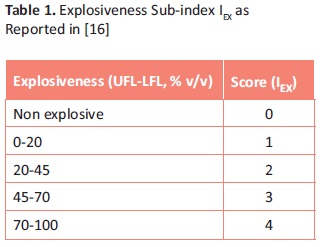
Quite clearly, the classification of risks based on the cited parameters is oversimplified when applied to inherent safety because it misses many relevant chemical and physical phenomena, essential for the definition of the hazard level of substances. Hence, this paper proposes inherent safety indexes based on recent advances in combustion-safety and on well-known methodologies for consequence analysis.
PRINCIPLES OF INHERENT SAFETY FOR FIRES AND EXPLOSION
General principles of inherent safety have been described by Kletz [20]. When flammable materials are considered, that is, when fire and explosion scenarios are under analysis, these principles may be reduced to four as in the following scheme [18,19].
(i) Substitute (Substitution): changing the fuel for less hazardous materials in terms of propensity to ignite or likelihood of observing fame propagation is an important step for the reduction of the global hazard of processes;
(ii) Minimize (Intensification): the reduction of inventories or volumes of fammable materials required in the process is essential to reduce the likelihood and severity of fres and explosion
(iii) Moderate (Attenuation/Limitation of effects): the effects of combustion energy releases may be minimized by proper design, or by segregating process units for knock-on effects, or changing process conditions (temperature, pressure)
(iv)Simplify (SimplificationlError tolerance): using equipment that is able to withstand maximum pressure and avoid complexities such as congested pipes or unit settings are essential in protecting against the risk of explosion.
In this framework, [19] have stated that inherent safety analysis should always rely on the underlying chemical and physical properties of the materials or process.
If considering the case of fammability and explosibility however, ruling out non-industrial substances such as, for example, condensed phase (military) explosives, an essential set of thermophysical and kinetic parameters should be considered as a starting point of any analysis. In Table 2 we have listed the main parameters needed for the risk evaluation of any hazardous system.
These data are surely useful for the preliminary comparison of fre and ex-plosion risks, but do not include all the necessary information on either the hazard or the consequence of the accidental scenarios, which should be frst defined for an effective inherent safety analysis.
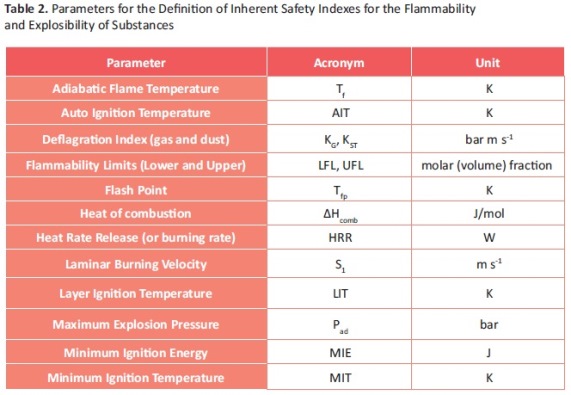
With specific reference to the industrial explosion related to combustion phenomena, we can summarize the following scenarios:
1)Flammable gases or vapours may produce destructive gas or vapour cloud explosion, in the open atmosphere, only if large loss of containment and delayed ignition occur. Flammability limits (LFL, UFL) and the laminar burning velocity are important for the evaluation of the fammable cloud geometry and for its fundamental reactivity.
2) If confined or partially confined systems are of concern, fre and explosion of gases, dust or vapours may be destructive due to simple thermodynamic consideration related to the hot combustion products (Maximum Explosion Pressure, Pad), which pressurize the given equipment even if the escalation of pressure may be effectively mitigated. In this regard, the gas defagration or dust defagration indexes (KG, KST) are essential for the correct design of a mitigation system, e.g. venting.
3) Flammable dusts (solid) can explode only if suspension is formed, which occurs mainly in confined or partially confined systems. Unlike gases and vapours, the ignition mechanism may be important for the prevention and mitigation of dust explosions: Minimum Ignition Energy (MIE), Minimum Ignition Temperature (MIT), and Auto Ignition Temperature (AIT) are essential. Furthermore, the dust diameter is a main parameter affecting the dust dispersion and suspension.
Table 3 gives the flammability limits, their difference and the laminar burning velocity for a set of gases and vapours typically used in the chemical and process industry.
Quite clearly, inherent safety indexes based only on flammability ranges may fail. E.g. propane has a lower range than carbon dioxide or methane, which are by no means less hazardous fuels (CO has a very large flammability limit range (62.5), but the lowest laminar burning velocity). Hence, a larger flammability limit range does not reflect a larger reactivity. Furthermore, the flammability ranges do not take into account the role of turbulence (congestion) on flame speed, which is the main element responsible for the likelihood and severity of an explosion [3]. Finally, it should be noted that flammability limits are not specific properties of the substance: their values are defined at 25°C, 1 bar, and are strongly affected by temperature, pressure, and measurement systems.
Within this framework, new proposals for safety indexes, aiming at inherent safety analysis, will be shown in the following section.
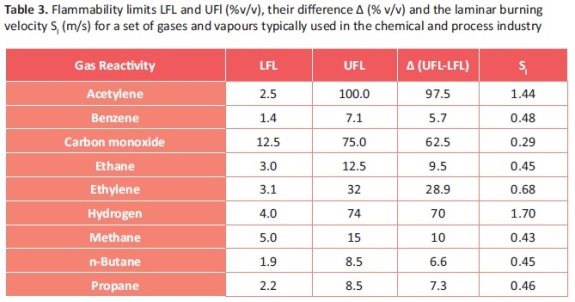
NEW INDEX FOR INHERENT SAFETY RELATED TO EXPLOSION
The inherent indexes should take into account not only the substance properties including reactivity, but also their coupling with the accidental scenarios which may occur in the process industry. In the following, we propose the inherent indexes suitable for three different industrial scenarios: confined gas and vapour explosion, unconfined and partially confined gas and vapour cloud explosion, confined dust explosion. Details on these accidental phenomena are reported elsewhere [21] and will be not reported here for the sake of brevity.
Unconfined and Partially Confined Gas and Vapour Cloud Explosion
Accidental explosions of gas or vapour clouds in the atmosphere are the result of the interaction of fluid-dynamic (turbulence), geometry and chemical reactions (the combustion reaction), often referred to as the positive feedback of turbulent combustion. The consequent generation of pressure waves (blast or shock wave) is possible, only if the variation over time of the flame area and burning velocity is significant [3].
According to the Baker-Sthrelow methodology for the prediction of explosion behavior of vapour and gases in medium-scale semi-confined environment, the flame Mach number (Maf) should be evaluated. In Table 4, the Maf is given as the computed function of geometrical consideration (confinement, congestion) and reactivity [24].
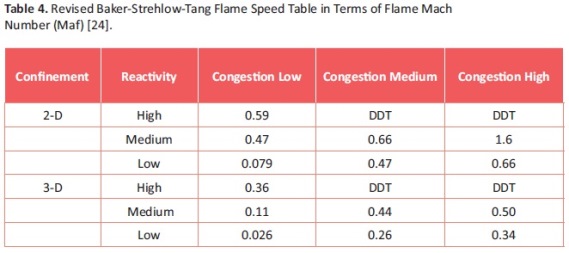
In Table 4, DDT stands for "deflagration to detonation transition". In this case, the risk of manipulating the gas/geometry system is very high and the installation of prevention measures is the only feasible safe alternative, so that any substitution or limitation is welcome.
In deflagration modes, the data can be re-arranged to link the classification as function of the reactivity (burning velocity Sl):
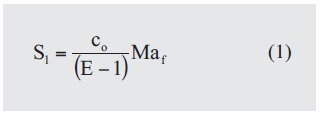
The high reactivity fuels are hydrogen, acetylene, ethylene oxide and propylene oxide (the latter two are not considered here because several complexities arise when treating these very hazardous gases). Low reactivity includes the sole methane and carbon monoxide. All other gases are at medium reactivity.
The dependence of reactivity (i.e. Sl) from equivalence ratio (concentration), temperature and pressure should also be taken into account by considering literature correlation or direct proportionality for the values at ambient temperature (T°) and pressure (P°):
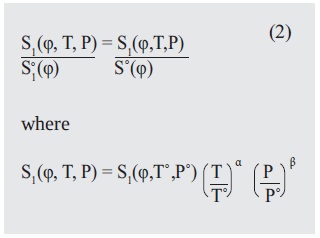
On the basis of Table 4 and Eqs.1-3), new specific explosion sub-indexes can be defined taking into account the fuel reactivity and the scenario (2D or 3D expansion, unconfined or partially confined system). The results are shown in Table 5.
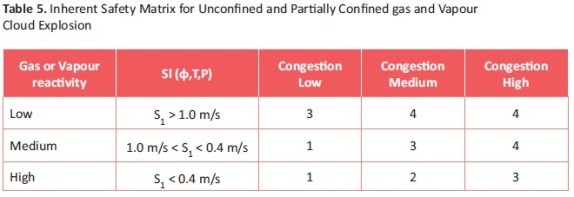
These indexes are useful also for fuel mixtures if the laminar burning velocity of fuel mixtures is used.
Confined Gas and Vapour Explosion
The thermodynamic values of flame pressure and temperature should be considered for inherent safety comparison, as this knowledge is needed for the definition of equipment integrity (comparing the maximum pressure with equipment failure pressure) and for mitigation purposes (venting system). In the latter case, the rate of pressure rise is needed for the efficiency of the venting system response, also. Hence, the gas deflagration index (KG) is introduced. This index may be justified theoretically starting from laminar burning velocity of fuel-air mixtures, together with considerations on scale and geometry, through the Lewis von Elbe (1987) correlation:
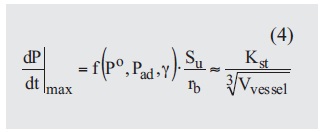
where rb is the burned radius, rvessel is the vessel equivalent radius, P°, Pad and γ are respectively the initial pressure, the maximum pressure reached by the explosion in adiabatic conditions and the specific heat ratio of the mixture. The constant value of maximum rate of pressure rise for a given vessel dimension depends however on the assumptions that: i) dP/dt is maximum when the radius of burned materials is equivalent to the radius of the vessel; ii) the laminar burning velocity is constant. This latest assumption is by far a limitation of the cubic-root law. However, a classification of substance through this index may be effective.
Confined Dust Explosion
When dust explosions are of concern, the Kst value (dust deflagration index) is typically adopted for classification and comparison. The dust deflagration index comes from the so-called "cubic-root law" similarly to the gas deflagration index cited above, even if important difficulties arise when considering laminar burning velocity when working with dust suspension. Furthermore, the value of Kst varies with several properties of the materials such as particle diameter, turbulence induced before ignition by dispersion methodology, humidity and dust shape (9,7)
Within this framework, Amyotte et al. (2009) have discussed the substitution effects for dust explosion based on Kst and particle distribution. Indeed, most of standards provide a basis for a combustible dust to be defined as explosive if particle sizes are less than or equal to 420 μ (as in the case of FM Global, see [12].
Finally, dusts are almost never present as a single size, but a whole range. The finer the mixture, the more likely it will ignite: the larger particles may not participate in the initial explosion to any great degree, but most of dust explosions have a fireball and combustion taking place outside the enclosure where the event starts.
Regarding dust explosions, we have also recently analyzed the case of the presence of flocks or hybrid mixtures (either with flammable vapours or gases) [13], [26]. These added effects are typical in industrial environment and may certainly affect the results.Finally, there is no rule to classify the explosibility of dusts unless deterministic analysis (experiments) and simple comparison is possible on the basis of pre-defined data such as that retrieved on a database.
The widely used classification based on Kst could, thus, be combined with particle distribution if considering that very small diameters are likely to explode, with increased severity. The proposed classification is based on the assumption that the upper threshold limit for the dust explosibility corresponds to an average distribution of particle diameter of about 250-500 μ m, and that 70 micron represents the standard for many international standard e.g. ASTM and UNI-EN. Hence:
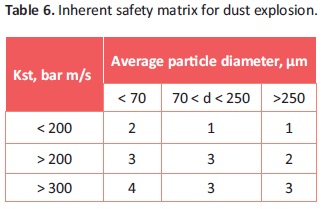
CONCLUSIONS
The explosion indexes need to be re-evaluated on the basis of the most important safety parameters and cannot rely exclusively on the flammability properties. The results may be easily implemented in existing methodologies for Inherent safety KPIs or extended in domino effect methodologies [6], [27].
REFERENCES
[1] P. Abedi, M. Shahriari. "Inherent safety evaluation in process plants – a comparison of methodologies". Central European Journal of Chemistry. Vol., 3 No. 4 Nov, 2005 pp. 756–779. [ Links ]
[2] P.R. Amyotte, M.J. Pegg, F.I. Khan. "Application of inherent safety principles to dust explosion prevention and mitigation". Process Safety and Environment Protection. Vol., 87, No. 1 Jan, 2009 pp. 35–39. [ Links ]
[3] W.E. Baker, P.A. Cox, P.S. Westine, J.J. Kulesz, R.A. Strehlow. Explosion Hazards and Evaluation. New York: Elsevier, 1983. [ Links ]
[4] W. Bartknecht. Explosions Course Prevention Protection. Berlin: Springer Verlag, 1981. [ Links ]
[5] H.F. Coward, G.W. Jones. Limits of flammability of gases and vapors. USA: Bureau of Mines Bulletin 503, 1952. [ Links ]
[6] V. Cozzani, E. Salzano, A. Tugnoli. "The development of an inherent safety approach to the prevention of domino accidents". Accident Analysis and Prevention. Vol., 41 No. 6 Nov, 2009 pp. 1216-1227. [ Links ]
[7] A. Di Benedetto, P. Russo, P. Amyotte, N. Marchand. "Modelling the effect of particle size on dust explosions". Chemical Engineering Science. Vol., 65, No. 2. Jan, 2010, pp. 772-779 [ Links ]
[8] Dow Chemical Company. DOW's Fire & Explosion Index Hazard Classification Guide. 6th Edition. New York: American Institute of Chemical Engineers, 1987. [ Links ]
[9] R.K. Eckhoff. Explosion Hazards in the Process Industries. Austin, TX: Gulf Publishing Company, 2005. [ Links ]
[10] D.W. Edwards, D. Lawrence. "Assessing the Inherent Safety of Chemical Process Routes: Is There a Relation Between Plant Costs and Inherent Safety?" Process Safety and Environmental Protection. Vol., 71 No. B4. Nov, 1993 pp. 252–258. [ Links ]
[11] D.W. Edwards, D. Lawrence, A.G. Rushton. "Quantifying the Inherent Safety of Chemical Process Routes". 5thWorld Congress of Chemical Engineering. Vol., 2. Jul, 1996, pp. 1113–1118. [ Links ]
[12] H.L. Jr. Febo. "Combustible Dust Hazard RecognitionAn Insurer's View". Process Safety Progress. Vol., 30 No. 1. March, 2011, pp. 82-86. [ Links ]
[13] A. Garcia-Agreda, A. Di Benedetto, P. Russo, E. Salzano, R. Sanchirico. "Dust/gas mixtures explosion regimes". Powder Technology. Vol., 205 No. 1-3. Jan, 2011, pp. 81–86. [ Links ]
[14] M. Gentile, W. Rogers and M.S. Mannan. (Oct. 2001) "Development of an Inherent Safety Index Using Fuzzy Logic". Presented in: 2nd Annual Symposium of Mary Kay O'Connor Process Safety Center. Beyond Regulatory Compliance, Making Safety Second Nature. [electronic medium]. Available: http://pscfiles.tamu.edu/symposia/2001/MichelaGentileMKOPSC.pdf [ Links ]
[15] I. Glassman, R.A. Yetter, Combustion, 5th Edition. New York: Academic Press, 2008. [ Links ]
[16] A.M. Heikkilä. Inherent safety in process plant design: An index-based approach. Finland: VTT Publications, 1999 pp. 384. [ Links ]
[17] Imperial Chemical Industries Limited. The Mond index: how to identify assess and minimise potential hazards on chemical plant units for new and existing processes (2nd ed), Winnington, Nortwich, Cheshire: Imperial Chemical Industries PLC, Explosion Hazards Section, Technical Dept, 1985. [ Links ]
[18] F.I. Khan, P.R. Amyotte. Inherent Safety in Offshore Oil and Gas Activities: A Review of the Present Status and Future Directions". Journal of Loss Prevention in the Process Industries. Vol.,15 No. 4. Jul, 2002, pp. 279–289. [ Links ]
[19] F.I. Khan, P.R. Amyotte. How to Make Inherent Safety Practice a Reality. The Canadian Journal of Chemical Engineering. Vol., 81 No. 1 May, 2003, pp. 2-16. [ Links ]
[20] T.A. Kletz. Plant design for safety – A user friendly approach, 2nd Edition, United Kingdom: Taylor and Francis, 1991. [ Links ]
[21] F.P. Lees. Loss Prevention in the Process IndustriesHazard Identification, Assessment, and Control. Oxford: Elsevier/Butterworth-Heinemann, 2005. [ Links ]
[22] C.T. Leong, A.M. Shariff. Process route index (PRI) to assess level of explosiveness for inherent safety quantification. Journal of Loss Prevention in the Process Industries. Vol., 22, No. 2 Mar, 2009 pp. 216–221. [ Links ]
[23] B. Lewis, G. Von Elbe. Combustion, flames, and explosions of gases. Academic Press, 1987. [ Links ]
[24] A.J. Pierorazio, J.K. Thomas, Q.A. Baker, D.E. Ketchum, An update to the Baker–Strehlow–Tang, vapor cloud explosion prediction methodology flame speed table. Process Safety Prog. Vol., 24 No.1 Jan, 2005, pp. 59–65. [ Links ]
[25] M. Rahman, A.M. Heikkila, M. Hurme. Comparison of inherent safety indices in process concept evaluation. Journal of Loss Prevention in the Process Industries. Vol., 18 No. 4-6. Nov, 2005 pp. 327–334. [ Links ]
[26] P. Salatino, R. Chirone, A. Di Benedetto, E. Salzano, R. Sanchirico. Analysis of an explosion occurred in a wool processing plant. Industrial & Engineering Chemistry Research. Vol., 51, 2012, pp. 7713-7718. [ Links ]
[27] A. Tugnoli, G. Landucci, E. Salzano, V. Cozzani. Supporting process and plant design choices by Inherent safety KPIs. Journal of Loss Prevention in the Process Industries. Vol., 25, 2012, pp.830–842. [ Links ]













